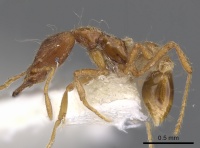Strumigenys eumekes
| Strumigenys eumekes | |
|---|---|

| |
| Scientific classification | |
| Kingdom: | Animalia |
| Phylum: | Arthropoda |
| Class: | Insecta |
| Order: | Hymenoptera |
| Family: | Formicidae |
| Subfamily: | Myrmicinae |
| Tribe: | Attini |
| Genus: | Strumigenys |
| Species: | S. eumekes |
| Binomial name | |
| Strumigenys eumekes Bolton, 2000 | |
The type material was collected from under a stone in a lowland rainforest.
Identification
Bolton (2000) - A member of the godeffroyi complex in the Strumigenys godeffroyi-group. At first glance the smooth pronotum of this species is reminiscent of the much more common Strumigenys juliae, but that species has a broader head, longer mandibles and shorter scapes than eumekes. In addition, the flagellate hairs of eumekes are much longer and more numerous than in juliae and the latter lacks such hairs on the cephalic dorsum whilst eumekes has two pairs. See also notes under Strumigenys nanzanensis.
Keys including this Species
Distribution
Distribution based on Regional Taxon Lists
Indo-Australian Region: Borneo (type locality), Indonesia, Malaysia.
Distribution based on AntMaps
Distribution based on AntWeb specimens
Check data from AntWeb
Countries Occupied
| Number of countries occupied by this species based on AntWiki Regional Taxon Lists. In general, fewer countries occupied indicates a narrower range, while more countries indicates a more widespread species. |

|
Estimated Abundance
| Relative abundance based on number of AntMaps records per species (this species within the purple bar). Fewer records (to the left) indicates a less abundant/encountered species while more records (to the right) indicates more abundant/encountered species. |

|
Biology
Castes
Nomenclature
The following information is derived from Barry Bolton's Online Catalogue of the Ants of the World.
- eumekes. Strumigenys eumekes Bolton, 2000: 790 (w.) BORNEO.
Unless otherwise noted the text for the remainder of this section is reported from the publication that includes the original description.
Description
Worker
Holotype. TL 2.2, HL 0.62, HW 0.39, CI 63, ML 0.22, MI 35, SL 0.39, SI 100, PW 0.26, AL 0.67 (ML and MI approximated a s apices o f mandibles broken).
Characters of godeffroyi-complex. Cephalic dorsum with pair o f erect hairs closest to midline on occipital margin long and subflagellate, strongly curved anteriorly in their apical halves. Cephalic dorsum with a second pair of extremely long erect flagellate hairs, located close to the lateral margin, just anterior to highest point of vertex; in profile these hairs longer than maximum depth of head. Apicoscrobal hair flagellate and exceptionally long and fine, 0.34 mm., ca 0.87 X SL. With head in full-face view the dorsolateral margin posterior to the flagellate hair has a row of 2-3 stiff simple projecting hairs that curve anteriorly. These hairs contrast with the marginal hairs anterior to the flagellate hair as they are more cylindrical (i. e. not long-spatulate), more elevated and less strongly curved anteriorly. Ground-pilosity on pronotal dorsum long-spatulate, moderately dense and somewhat elevated but not appearing as a pelt. Dorsum and side of pronotum smooth and shining, without reticulate-punctate sculpture. Mesonotum finely reticulate-punctate. Dorsum of pronotum with a pair of erect long flagellate hairs in addition to the humeral pair; the latter extremely long, each one ca 0.34, much longer than PW. Pleurae and side of propodeum glassy smooth. Propodeal declivity with a broad and very conspicuous spongiform lamella. Propodeal teeth very weakly expressed (may be vestigial), entirely confluent with the lamella and surmounted by a convex crest of spongiform tissue. Disc of postpetiole unsculptured. Basigastral costulae conspicuous but short, their length on the tergum proper no greater than width of the limbus.
Type Material
Holotype worker, Malaysia: Sarawak, 4th Div., G. Mulu Nat. Pk, RGS Expd., Long Pala, 21.ix.1977, lowland rainforest, under stone (B. Bolton) (The Natural History Museum).
References
- Bolton, B. 2000. The ant tribe Dacetini. Memoirs of the American Entomological Institute. 65:1-1028. (page 790, worker described)
References based on Global Ant Biodiversity Informatics
- Pfeiffer M.; Mezger, D.; Hosoishi, S.; Bakhtiar, E. Y.; Kohout, R. J. 2011. The Formicidae of Borneo (Insecta: Hymenoptera): a preliminary species list. Asian Myrmecology 4:9-58

